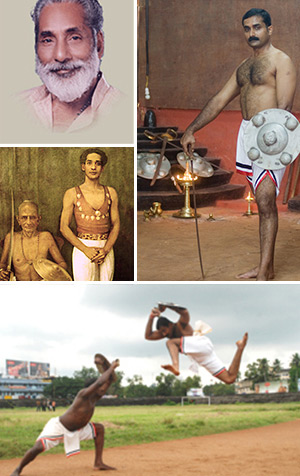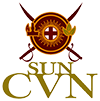Kalaripayattu

Sun CVN Kalari
A home of Kailaripayattu, the traditional healing science based martial art of Kerala.
Where you can become a real Army of One.
Kalari fighters really were ''an army of one.''Thought they worked in groups. they fought each battle alone.
Though the name came from else-where,they were using organized 'guerrilla' tactics millennia before anyone else. The hilly, sub-tropical. Coconut - forested terrain of south india moulded this martial art.
The 'arts' of southeast Asia, from indonesia and Thailand, to the Philippines, Japan, China and Korea all imported this martial art and adapted it to their way of thinking. The vehicle was Buddhism.
Kalari training and tactics are fit for the 'street,' that is, self-defense, anywhere in today's world. In the old days those fighters began training at about eight, and by their late teens. They were dangerous, nearly super-human, soldiers. The Nairs, the warrior caste were even matriarchal so that the loss of a fighter would not disrupt family continuity. Fighting to the death was a foregone conclusion - win or die fighting.
KERALA, the indian state where Kalaripayattu is believed to have developed, stayed fiercely independent long after the rest of the subcontinent submitted. In fact the ''malabar coast'' visited by the Egyotians, Greeks, the Romans and Chinese since at least 3000 BCE, stayed independent as the princely state of Travancore and did not join the rest of india untill 1958.
The KALARI, or training ground, also served as a school, presided - over by a gurukkal. He served as teacher, doctor, surrogate father and spiritual advisor - for life. Even the dimension of the Kalari were based on that particular guru's foot size-42''feet'' by 21 "feet", built halfway below ground to keep the temperature constant, the fighters touched the feet of the their gurukkal, as the living embodiment of the knowledge of all the gurus before him, each day at dawn, before training. The honorific, kkal, in gurukkal, is a plural form of the word ''teacher''to signify that long line of teacher stretched back into the fog of antiquity.
These young men and women learned the collective arts of Kalaripayattu, a compound malayalam word meaning roughly,''battle-ground training.' ''kal''means to 'kick'or to go forward as if into battle.' it's related through latin to the modern word; calorie'. meaning ' a unit of heat expended .' A Kalari is a place for doing that, and payattu means ' to fight' or 'practice fighting,' or like Kung Fu'' to put hard physical work into something'' for a long time.
A Kalari is place where hard physical work is performed, but it is also a form of worship. Each routine, bare - handed and with each weapon, is a moving spiritual journey or form of meditation. This is what the man the chinese called ''Ta Mo''(the Bodhidharma) brought to the shaolin monks-physical exercise as a form of worship, a form of transcendental meditation that the chinese call Ch'en and the Japanese call ZEN Buddhism. He taught the monks to focus their mindes as if their lives depended upon it. If not the first matiral art, Kalaripayattu is certainly the oldest still practiced. Initially, one learns to control and care for one's body and to flex, twist and move it through space as if by magic. Concurrently, one learns mental and physical balance. Ultimately, one learns to focuse those skills into a very formidable weapon, not one you carry-one you are.
Then the student turns to healing, learning a remedy for practically every injury he might inflict. And to prepare and apply phenomenal oils with anatomically active massage that has nothing in common with any other culture's use of the word 'massage'. One student said he knew how a French Fry felt after a full body massage. Another compared the foot massage to being "run over by a steam roller.' Both students have dedicated themselves to learning the art. Massage does more than make muscles pliable, it corrects imblances internally and spityrally, much an acupuncture and shiatsu do.
Early in the last century, when Kalari training was still countary to colonial policy, a gifted yong man named C.V.Narayanan Nair codified Kalari training. It is from him that the "CVN" comes in our name. His codification has done much to strengthen the bonds between individual Kalaris and minimze the friction between masters. He was some fighter, considered almost a saint among Northen style Kalaripayattu practitoners, but the few photographs suverving reveal a profound innate humility.
This codification led the government of Kerala to mandate meipayattu in all Kerala's public schools. Meipayatty is the initaial physical training that grew into Kalaripayattu without teaching martial techniques. Those techniques ultimately are the basis of attack on the "Marma" points or their treatment to resotre mental and physical health.
We modestly invite you to the SUN CVN Kalari with the famous thought "Athithi Devo Bhava" which encougages us to consider the guest as a divine presence.
Training
Training courses varying from 3-6months are offered at SUN CVN Kalari. These courses address the basis of Kalaripayattu and impart to the learner a comprehensive peep into it ancient martial art subsequent to this, learners seeking to pursue higher levels of the course are welcome to do so. The training course are customisable based on the time availible to the learner.
Lecture - Demonstrations
Familiarisation of the nuances of Kalaripayattu is done with the help of lecture demos spanning 1-2 hour. Herein, the GuruKKal and his disciples will perform various martial exercises using weapons in both solo and group manoeuvres.





